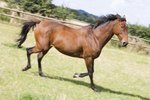
Equine conformation evaluation involves studying the build of a horse to assist in determining his physical ability and potential. The flank area of your horse is located immediately in front of the horse's sheath or udder. The flank includes the rear lower line of the horse's abdomen area. The shape of the flank implies certain things about the horse's conformation as well as his capabilities under saddle.
Flank Conformation
Picture a healthy horse with a deep chest, a wide back and a healthy barrel that transitions smoothly into a muscular hindquarter. Without good flank conformation, the horse will appear wasp-waisted, dipping in significantly on either side of the barrel immediately before the hindquarter. The ideal flank should be deep and fairly wide, and provide plenty of room for the horse's internal organs. The exact dimensions of the ideal flank vary by breed, but a deep and well-proportioned flank that does not have a pinched or narrow look is preferred.
Shallow Flank Appearance
Your horse has flanks on both sides of his body; they will be identical in appearance. Horses with a shallow flank are sometimes called "wasp-waisted" or "herring-gutted." These terms mean the horse's flank has a narrow, tucked-in appearance similar to that of a greyhound dog. A shallow flank will dip in between the barrel of the horse and the hindquarter rather than flowing together smoothly. A shallow flank is considered to be a conformation flaw; horses with this trait should not serve as breeding stock.
Shallow Flank Problems
Nothing prevents a shallow-flanked horse from being a suitable riding horse, but shallow conformation leaves such horses with certain weaknesses. The shallow-flanked horse's bowels and organs have limited room compared with those of horses who have a more correct conformation. Because such horses have less internal space for their organs, the common belief is that their lungs are not able to expand as fully as those of ideal-flank horses, precipitating an overall lack of endurance and stamina during hard work, according to the United States Pony Club. However, this is not necessarily true in every case. Both conformation and conditioning will play a part in determining stamina, but if you are looking for a horse to use in riding disciplines that require deep breathing and a significant amount of stamina, you probably want to stay away from horses with this conformation flaw.
Carrying Weight
The flanks of a wasp-waisted horse generally do not have as much muscle development as those of conformational horse. According to the United States Pony Club, the lack of musculature can cause the horse's back and loin to be weaker, generating less power in the hind end, or thrust. Due to the lack of muscle development, such horses may also have difficulty carrying heavier riders.
References
- International Model Equine Hobbyists Association: Back Confromation
- Washington State University: Horse Conformation Analysis
- Cornerstone Morgan Club: Judging Barrel Conformation
- Alberta Agriculture and Rural Development: 4-H Judging Manual
- United States Pony Club: Middle California Region Upper Level Horse Management Education Conformation Analysis
Photo Credits
-
BananaStock/BananaStock/Getty Images
Writer Bio
Jen Davis has been writing since 2004. She has served as a newspaper reporter and her freelance articles have appeared in magazines such as "Horses Incorporated," "The Paisley Pony" and "Alabama Living." Davis earned her Bachelor of Arts in communication with a concentration in journalism from Berry College in Rome, Ga.




